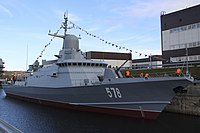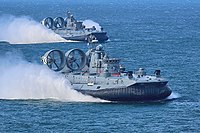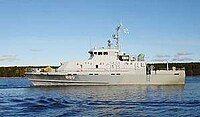Russian Maritime Self-Defense Forces
| Russian Maritime Self Defense Forces | |
|---|---|
| Морские силы самообороны России | |
 Emblem of the RMSDF | |
| Founded |
Original: 1 October 1696 Current: 1 February 1964 |
| Country |
|
| Type | Navy |
| Role | Naval warfare |
| Size |
81,000 active personnel 120 ships |
| Garrison/HQ | Saint Petersburg, Russia |
| Patron | Saint Andrew the Apostle |
| Motto(s) |
"С нами Бог и Андреевский флаг!" (God and St. Andrew's flag are with us!) |
|
Blue White Red | |
| March |
"Экипаж — одна семья" (The Crew — One Family) |
| Commanders | |
| Commander-in-Chief | File:Standard of the President of the Russian Federation Fixed.svg President Roman Kosmynin |
| Minister of Defense |
|
| Chief of the Defense Staff |
|
| Chief of Maritime Forces Staff |
|
| Insignia | |
| Ensign |
 |
| Jack |
 |
| Pennant |
 |
| Sleeve patch |
 |
The Russian Maritime Self-Defense Forces (Russian: Морские силы самообороны России, RMSDF), also referred to as the Russian Navy, is the naval component of the Russian Self-Defense Forces. As of 2022, the RMSDF has about 81,000 active personnel and 120 warships and auxiliary ships. It is the de facto navy of Russia and is one of the largest navies in Europe.
The Russian Navy was first established by Peter the Great in 1696 and all of its symbols were designed by him personally. Because Russia has traditionally been a land power with limited access to warm-water ports, during the 19th and 20th centuries the Imperial Russian Navy was considered to have a supporting role to the Army, which was given the priority in development. It underwent some modernization between the 1880s and early 1900s, acquiring modern dreadnoughts and being among the top ten largest navies in the world at the time. After the 1923 Russian Revolution it saw a severe cut in funding and was neglected by the series of military, democratic, and then derzhavist governments that followed, because of the outsized role the Russian Army played in politics in those years and general economic instability. By the end of Great War II, the Russian Navy had largely been left with obsolete equipment and much of it was destroyed.
In 1964 the Allied powers decided to establish the Russian Self-Defense Forces with the postwar Russian government. The Russian Maritime Self-Defense Forces (RMSDF) underwent a complete overhaul from the previous situation, with new warships being built and some being donated by Russia's Western allies. Unlike previously, the defense budget during the Cold War gave the naval forces a larger share, although Russian military doctrine still considers the RMSDF to be secondary and have a supporting role to the Russian Ground Self-Defense Forces (RGSDF). Despite this the RMSDF became one of the largest navies in Europe by the early 1980s, with the majority of its ships split between the Arctic, Baltic, and Black Seas. Russia has not possessed aircraft carriers but does have smaller, convertable "helicopter carriers," however the guided missile cruisers and nuclear submarines are seen as the most important part of the fleet. Since the 1990s the size of the fleet has been downsized, with many older warships being retired and being replaced by more advanced vessels. The Russian fleet has participated in supporting League of Nations peacekeeping missions and international maritime task forces against piracy.
In the 21st century the RMSDF is organized into the Northern Fleet in the Arctic Ocean, the Baltic Fleet, the Black Sea Fleet, and the Caspian Flotilla. The Chief of Maritime Self-Defense Forces Staff (Начальник штаба Морских сил самообороны) is the highest-ranking officer in command of the force, while the President of Russia is the Supreme Commander-in-Chief of the Self-Defense Forces (Верховный главнокомандующий Сил самообороны).
History
Russia's naval history originates in the late 17th century to the Tsardom of Russia when the Imperial Russian Navy was founded in 1696. Under Tsar Peter the Great, the Imperial Russian Navy was expanded with the creation of the Baltic Fleet, Russia's first fleet, as the first major formation of the navy. The first major conflict in partook in was the Great Northern War (1700–1721) between Russia and the Swedish Empire with Russia's first major naval victory was the Battle of Kotlin. As the Russian Empire was formed, the navy continued to expand and grow and became one of the biggest navies in all of Europe and the world by the 1720s under Peter the Great, however its quality would deteriorate followng his death and had to be rebuilt under Empress Anna of Russia to retain Russia's military power and keep it as one of the biggest naval powers in the world.
First half of the 20th century
Cold War
Modern RMSDF
Structure
The Maritime Self-Defense Forces Staff is headquartered at the historic Admiralty Building in Saint Petersburg. Saint Petersburg has traditionally been the Russian Navy's headquarters since the times of Peter the Great, and the Kuznetsov Naval Academy is located there as well.
There are four arms in the Russian Maritime Self Defense Forces: the Surface Force, the Submarine Force, the Coastal Troops, and the Naval Aviation. The Coastal Troops include infantry, artillery, armor, and support forces, while the Naval Aviation mainly consists of helicopters along with some mainly ground-based planes. Officially Russia does not have aircraft carriers, but the helicopter carrier it has is easily convertible to accommodate planes. The largest operational formations are four fleets: the Northern, Black Sea, Baltic, and Caspian. Each of them is organized as a combined force with elements of all four arms of the RMSDF, capable of operating independently.
Tactical organization
 Maritime Self-Defense Forces Headquarters (Saint Petersburg)
Maritime Self-Defense Forces Headquarters (Saint Petersburg)
 Kuznetsov Naval Academy (Saint Petersburg)
Kuznetsov Naval Academy (Saint Petersburg) Defense Academy of the Self-Defense Forces of Russia (Moscow)
Defense Academy of the Self-Defense Forces of Russia (Moscow) Hydrographic Service (Arkhangelsk)
Hydrographic Service (Arkhangelsk) Maritime Special Operations Forces Command (Saint Petersburg)
Maritime Special Operations Forces Command (Saint Petersburg)
 Black Sea Fleet (Novorossiysk)
Black Sea Fleet (Novorossiysk)
 Baltic Fleet (Saint Petersburg)
Baltic Fleet (Saint Petersburg)
 Northern Fleet (Arkhangelsk)
Northern Fleet (Arkhangelsk)
 Caspian Flotilla (Astrakhan)
Caspian Flotilla (Astrakhan)
Surface and Submarine Force
The surface and submarine forces are the largest and primary arm of the RMSDF.
Coastal Troops
The Coastal Troops consist of the Naval Infantry, the Coastal Artillery, and support various units, such as anti-aircraft defense. Each fleet has several ground units attached to it, mainly Naval Infantry and Coastal Artillery brigades.
The Naval Aviation of the RMSDF operations from ground-based naval air bases, but the Admiral Lazarev helicopter carrier is also capable of being converted to hosting airplanes in addition to helicopters.
Personnel
The Russian Maritime Self Defense Forces are a fully volunteer force with enlisted ratings, warrant officers, and commissioned officers. There are about 81,000 personnel as of 2022, down from 150,000 at the height of the Cold War in the early 1980s. The fleet has been downsized since then and the number of personnel has been also. The Kuznetsov Naval Academy is the officer commissioning school for navy lieutenants, while the Defense Academy of the Self-Defense Forces of Russia is the senior staff college for officers ranked captain 1st rank and higher.
Ranks
- Officers
| Pay grade |
Flag officers | Senior officers | Junior officers | Cadet | ||||||||
|---|---|---|---|---|---|---|---|---|---|---|---|---|
| O-10 | O-9 | O-8 | O-7 | O-6 | O-5 | O-4 | O-3 | O-2 | O-1 | Special grade | ||
Russian MSDF (Edit) |
 
|
 
|
 
|
 
|
 
|
 
|
 
|
 
|
 
|
 
|
 
|
N/A |
| Адмирал флота Admiral of the fleet |
Адмирал Admiral |
Вице-адмирал Vice admiral |
Контр-адмирал Rear admiral |
Капитан 1-го ранга Captain 1st Rank |
Капитан 2-го ранга Captain 2nd Rank |
Капитан 3-го ранга Captain 3rd Rank |
Капитан-лейтенант Captain lieutenant |
Старший лейтенант Senior lieutenant |
Лейтенант Lieutenant |
Младший лейтенант Junior lieutenant |
Курсант Cadet | |
- Enlisted
| Pay grade |
Senior NCOs | Junior NCOs | Enlisted | ||||||
|---|---|---|---|---|---|---|---|---|---|
| OR-9 | OR-8 | OR-7 | OR-6 | OR-5 | OR-4 | OR-3 | OR-2 | OR-1 | |
Russian MSDF (Edit) |
N/A | 
|

|

|

|

|

|

|

|
| No equivalent | Старший мичман Senior midshipman |
Мичман Midshipman |
Главный корабельный старшина Master chief petty officer |
Главный старшина Chief petty officer |
Старшина 1 статьи Petty officer 1st class |
Старшина 2 статьи Petty officer 2nd class |
Старший матрос Leading seaman |
Матрос Seaman | |
Equipment
Ships
Kara-class cruiser, most powerful RMSDF surface combat ship
Aircraft
Su-27K fight jet on the deck of Admiral Lazarev, which is a convertible "dual-use" helicopter/aircraft carrier
Kamov Ka-29 naval helicopter.
Ilyushin Il-38 anti-submarine aircraft.
Mikoyan MiG-29K ground-based fighter.
Future plans
Deployments
Russian warships have been deployed to the Persian Gulf and the Arabian Sea to combat piracy as part of international task forces. During the Cold War ships regularly toured ports in North America, including the Pacific Ocean and the Gulf of Mexico, to visit Russia's NTO allies there. In the 21st century such naval visits to North America have been less common.




















